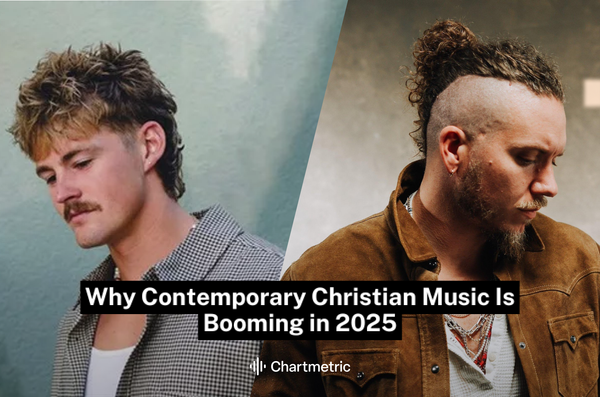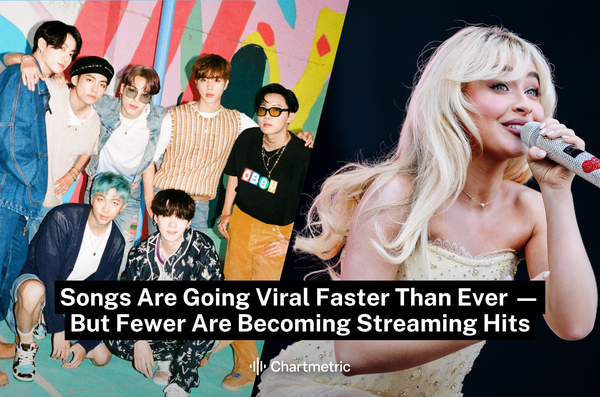Contemporary Christian music (CCM) has assumed many forms since its initial crossover explosion in the ‘90s: politely anarchic pop-punk, buzzy indie-rock, rap with a G-funk vibe—and that’s before we’ve even tiptoed into the zany world of “Weird Al”-style parody. These days, the genre jamboree continues, with social media-savvy artists hopping on board the free-for-all genre train of modern pop, blurring sonic styles and boundaries as a vehicle for their faith.
A new crop of Christian tunesmiths are revitalizing the canon and reaching mainstream audiences for the first time in years. Record-breakers like Forrest Frank (Chartmetric score 91.7 / rank 1.1K) and Brandon Lake (CM score 93.2 / rank 660) are joined by Alex Warren (CM score 97.2 / rank 58) —whose choral chart-topper “Ordinary” conjures spirituality and “the angels up in the clouds”—and by versatile artists such as Blessing Offor, whose songs have appeared on Grey's Anatomy and other top-rated television shows. Coincidentally, the trailblazing CCM Magazine also relaunched in August under new ownership, with its first cover story marking a “brand-new era for the storied music brand”, which notably coined the “CCM” label when it arrived on the scene in 1978.
Add to this the myriad non-CCM artists in 2025 infusing their music with religious, gospel, and spiritual themes—including Lana Del Rey, Big Freedia, and Rebecca Black, among others—and you could say that Christian pop is ostensibly riding a new wave of attention. The 2024 streaming data from Spotify, which showed a 60% rise in CCM listenership globally over a period of five years, certainly seems to account for the increased visibility and multi-chart success of these artists. Meanwhile, Chartmetric data helps to paint a broader picture, showing us how millennial and Gen Z streamers make up a significant portion of the listenership for this new flurry of CCM. But with the Pew Research Centre's 2023-24 Religious Landscape Study pointing to a decline in Christianity among the US’s '90s-born adults (56% in 2014 to 46% in 2023-24)—reporting that “today’s young adults exhibit far lower levels of religiousness than older adults”—how can we make sense of CCM’s renewed appeal among millennial and Gen Z listeners? And in what ways do these statistics reflect America’s cultural and socio-political currents?
As shown below, Spotify’s most-followed playlist, Christian Hits, began spiking around 2019 and again in 2025. We could interpret this data firstly within the context of the COVID-19 pandemic—which emerged in late 2019—as listeners sought more emotional support through music and had more time for at-home listening. Additionally, you can see that the vertical chart bars illustrating the latter half of 2025 are significantly higher than previous months that year, potentially alluding to the current political climate in the US, which has seen the return of conservative leadership intensify the connection between politics and Christian nationalism.
This trend can be replicated across other major Christian playlists as well, with both new and old experiencing significantly higher growth in 2024-2025 compared to previous years. Top Contemporary Christian and Christian Coffee house, for example, more than tripled their follower growth percentages from 2022-2023. Newer playlists, such as Beast Mode Christian and Praise and Worship, quickly rose as well.
Mood-boosting crossovers and collabs
The dual placement of worship leader and avowed conservative Christian Brandon Lake and Texan phenom Forrest Frank in the Billboard Hot 100 this spring certainly provides evidence of CCM’s ascent. In November 2024, Lake’s “Hard Fought Hallelujah” entered said chart at number 51 before leaping to 40 the following year, thanks to a collaboration with country maverick, Jelly Roll. Meanwhile, man-of-the-moment Frank—currently enjoying the full bloom of his ‘superstar’ era, according to Chartmetric data—crashed into the same chart in May with “Your Way’s Better”, peaking at number 61. These rankings marked the rare occurrence of two separate CCM artists breaching the mainstream spotlight at the same time—a chart feat not seen in over a decade.
For the most part, contemporary Christian pop has been bound to the Christian charts since the late-‘00s. As Billboard points out, only 11 tracks have historically broken into the mainstream chart, excluding holiday and crossover rap tunes. Making it onto this list of outliers are Hillsong United’s worship epic, “Oceans (Where Feet May Fail)” (2013), Carrie Underwood’s 2014 baptism belter “Something in the Water”, and Lauren Daigle’s 2018 strings-laced skyscraper “You Say”, a song anchored by its gospel-tinged chorus. How did these tracks succeed in crossing over? Arguably, part of their appeal lies in their relatability; although the lyrics are explicitly faith-based, the songs’ underlying themes—empowerment, self-belief, transformation—have universal relevance. Generally speaking, the music is also comforting and easy on the ear, which serves as the perfect complement to the emotionally resonant lyrical content.
Similarly, Frank and Lake channel an uplifting spirit of loyalty and positivity in their songs, generating the Chartmetric mood tags ‘faithful’ and ‘hopeful’, respectively. Much is known about the therapeutic potential of music, and while Frank’s earnest declaration (“Oh Lord, I need You now more than ever / Would You put my heart back together?”) may not scream mainstream marketability, something about this sunny bop has made an impact with listeners everywhere in 2025. The viral smash hit picked up an extra +11.3M (11.92%) Spotify streams (an 11.92 % rise) in the past month, bringing its total to 105.91M. Not quite a billion, but pretty good for an apparently culturally specific track that was only three months old at the time. Since 2018, Frank has been putting out solo Christian albums under his real name—embracing lo-fi hip-hop, alt-rock, indie-pop, and more—and in 2024 saw his career soar with the release of major label debut Child of God, which was nominated for Best Contemporary Christian Album at the 2025 Grammy Awards.
Meanwhile, Lake’s “Hard Fought Hallelujah” is nestled comfortably at the ‘mainstream’ track stage, with a track score of 95.13 and an additional 4.3M Spotify streams added to its tally in the past month.
Audience metrics and social media star power
Lake and Frank’s emotionally vulnerable music seems to hit all the right notes for Gen Z and millennial listeners, their biggest audiences, as confirmed by Chartmetric data.
An analysis of Frank’s audience breakdown shows that the majority of his listeners overwhelmingly fall between the 18-24 age range (48.4%), followed by 25-34 (35.9%). Also, most of his audience (57.2%) comes from the Gen Z and millennial-favoured platform, Instagram.
Naturally, social media is the fuel pushing this new Christian pop narrative into overdrive. Frank largely owes the success of “Your Way’s Better” to the virality of his Christian dance trend on TikTok, where he obtained more than 38.6M likes. Similarly, Lake’s audience primarily comprises 25-34 year-olds (43.9%) and 18-24 year-olds (27.4%), also with Instagram as his reigning platform, at 40.4%.
And Lake has a decent handle on his socials, too, with a combined social fanbase of more than 7.6M followers.
Dr. Leah Payne, an Associate Professor of American Religious History at Portland Seminary, podcaster, and author, who last year published the book God Gave Rock and Roll to You: a History of Contemporary Christian Music, observes how worship leaders like Lake have always been good at social media. She also partly attributes Frank’s success to the savviness of evangelical Christians, “with media and new forms of media … It doesn't surprise me that this music is spiking on these platforms, because they've always been early adopters of that stuff.”
Social media offers artists a platform to share their struggles, faith journeys, and reflections on spirituality, helping them to foster a closer connection to their fanbase. This, in turn, amplifies a core value central to so much CCM: authenticity. Maria Moua—a licensed psychotherapist with experience in music therapy who also has worked with young people as a worship leader—agrees that there is “a hunger” for authenticity among the post-millennial generation.
Echoing these sentiments, Frank spoke about aspiring to “make Christian music” he thinks “is cool” in a January 2025 interview with Grammy.com, adding: “I'm just making it the way that I love it. I think that authenticity is what kids resonate with.”
All of this brings us back to the initial question regarding the faith of today’s younger CCM streamers. Payne offers her take on the reported decline in Christian affiliation, reframing this within the context of waning interest towards traditional institutions, rather than a decline in spirituality. “They don't belong to denominations in the same way,” she offers. “They don't worship as frequently. I think contemporary Christian music is a business, and it is a market niche. And because of that, it doesn't really depend on those institutional markers.”
While Payne suggests that “there have been some notable, very much more diverse” acts within the CCM scene, for example, worship music collective Maverick City Music, she alludes to the fact that “Christian music is overwhelmingly white … I think it's no coincidence that the two leading figures that are a part of this boom are white men,” she adds.
Taken together, Payne’s insights can help to shed light on the paradox at the heart of the new Christian pop boom. There’s no denying the ability of today’s Christian pop artists to connect profoundly with listeners online, mixing tradition, faith, and the 2020s buzzword of ‘authenticity’ in ways that strike a chord with younger generations. But while the traditional formats of CCM have taken on a new digital identity (although Christian radio still holds plenty of star-making sway), its foundational image and values appear largely unchanged since the ‘90s. Whether an influx of CCM artists will flood the Billboard Hot 100 anytime soon remains to be seen; however, the genre’s mainstreaming appears to be underway, propelled by prevailing political trends and forces.





